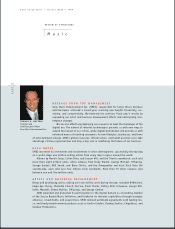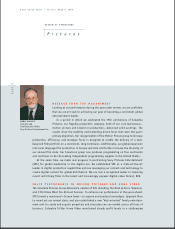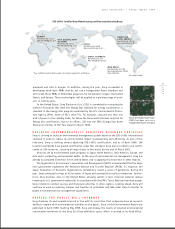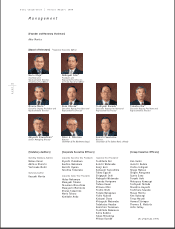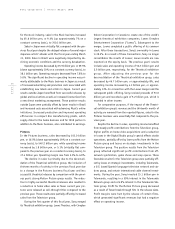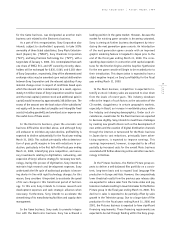Sony 1999 Annual Report Download - page 31
Download and view the complete annual report
Please find page 31 of the 1999 Sony annual report below. You can navigate through the pages in the report by either clicking on the pages listed below, or by using the keyword search tool below to find specific information within the annual report.
Sony Corporation Annual Report 1999
29
page
LIQUIDITY AND CAPITAL RESOURCES
Debt Finance and Liquidity Management
Sony’s financial policy is to maintain the strength of its
balance sheet while assuring adequate liquidity and financ-
ing for its operations. Among Sony’s principal objectives in
fulfilling that policy are seeking to assure liquidity by main-
taining adequate liquid assets and, to avoid excessive use
of its balance sheet, committed facilities, assuring that long-
term funding requirements are financed with long-term fi-
nancing and administering its financial requirements on a
regional basis.
It is a principal policy of Sony to keep total liquid as-
sets equal to at least 80% of the sum of the amount of the
largest expected monthly gross sales and the amount of
the largest expected monthly debt redemption during the
year. Liquid assets consist of cash and cash equivalents,
time deposits, and marketable securities. In addition to
these, Sony also includes committed lines as liquid assets
because funds are available from such lines during the pe-
riod of the contracts. By utilizing committed lines, Sony
intends to reduce excess cash items, in order to enhance
the efficiency of its use of assets. Sony, including its fi-
nance subsidiaries, has entered into contracts for commit-
ted lines with banks in a total amount of 230.9 billion yen
at March 31, 1999. As a principal policy, Sony selects banks
rated “C” or above in Moody’s Bank Financial Strength rat-
ings for its contracts for committed lines, and enters into
contracts with banks rated “A” or “B” with respect to more
than 70% of the total amount.
Sony’s primary financial policy for debt financing is to
match the duration of its funding requirements to the terms
of its debt. Long-term debt financing is utilized to meet
basic funding requirements, such as for investments in manu-
facturing facilities. Sony funds its short-term requirements
with a combination of short-term and long-term financing.
Sony uses long-term debt to fund a portion of its short-
term requirements because such funds are necessary on an
ongoing basis. Sony’s long-term debt principally comprises
notes including convertible bonds. Sony issued 1.5 billion
U.S. dollars of unsecured Notes in a global bond offering in
March 1998. In addition, Sony’s finance subsidiary in the
U.S. maintains a 3 billion U.S. dollar medium term note
(MTN) program and a 2 billion U.S. dollar Euro MTN pro-
gram. In addition, Sony’s finance subsidiary in the United
Kingdom maintains a 1 billion U.S. dollar Euro MTN
program. At March 31, 1999, the total outstanding balance
of MTNs was 172.7 billion yen. Sony maintains its flexible
financing ability in each market through these programs. In
addition to the above, SPE financed approximately 39.7
billion yen during the fiscal year ended March 31, 1999 in
Germany for its film production in the form of a film financ-
ing through a limited partnership associated with certain
third party investors.
In the U.S., Europe, and Asia, Sony carries out financ-
ing functions regionally through its finance subsidiaries in
order to minimize interest expenses and manage liquidity
efficiently. Finance subsidiaries in the U.S. and the United
Kingdom have U.S. commercial paper (CP) programs of 6
billion U.S. dollars and 1 billion U.S. dollars, respectively,
and finance requirements for operating funds through these
programs. During the year, peak month-end outstanding
balances were approximately 131.4 billion yen and appro-
ximately 55.5 billion yen, respectively. In Japan, Sony
Corporation centralizes cash management functions of its
subsidiaries, excluding Sony Life Insurance Co., Ltd. and
listed subsidiaries, through inter-company loans and
deposits, and maintains 300 billion yen of Japanese CP
issuance capacity. There was no CP issuance during the year.
Furthermore, in the U.S., Sony set up a 0.9 billion U.S. dollar
accounts receivable financing facility to enhance its short-
term financing capacity.
Sony’s financial condition remains strong. Sony believes
that its cash, other liquid assets, free cash flows and access
to capital markets, taken together, provide adequate re-
sources to fund ongoing operating requirements and future
capital expenditures related to the expansion of existing
businesses and development of new projects.
Assets, Liabilities and Stockholders’ Equity
Total assets decreased by 104.0 billion yen, or 1.6%, to
6,299.1 billion yen at March 31, 1999. This was principally
attributable to the appreciation of the yen at the end of the
fiscal year compared with the previous fiscal year-end, while
investment assets and deferred insurance acquisition costs
increased as a result of net increases in life insurance-
in-force. (It is estimated that total assets would have in-
creased by approximately 3% compared with the previous
fiscal year-end if the value of the yen had remained the
same at March 31, 1999 as at the previous fiscal year-end.)
Management’s Discussion and Analysis of Financial Condition
and Results of Operations



